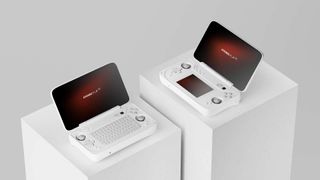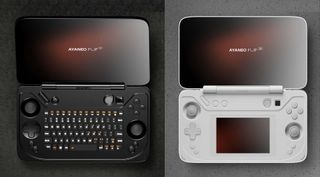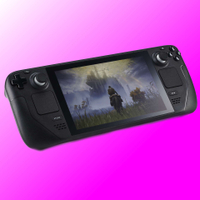The first Intel Meteor Lake handheld gaming PC breaks cover as does the most Nintendo DS PC you will ever see
Intel said all it needed was someone to build a Meteor Lake handheld and Emdoor is stepping up.

Update: Since the publication of this news article, the YouTube video has been removed.
Emdoor, a PC manufacturer that normally ships rugged systems for industrial use, is joining the portable gaming PC bandwagon with a machine that's uniquely different from all of the others. Rather than using one of AMD's all-in-one processors, this device will be sporting a new Intel Meteor Lake CPU.
As spotted by Twitter user harukaze5719, Emdoor's handheld gaming PC looks like it might be a pretty decent machine. Ignoring the chip for the moment, the rest of the specs are solid, with an eight inch 1920 x 1200 screen, up to 32GB of LDDR5X memory, and one M.2 slot that supports up to 2TB of storage.
Valve's Steam Deck uses a custom AMD processor, whereas the Asus ROG Ally sports an AMD Z1 or Z1 Extreme, a custom version of AMD's Ryzen 7 7840U used across most other handheld devices. However, Emdoor has gone down the Intel route for its EM-GP080MTL (yeah, it really needs a better name than that) and that really piqued my interest.
Mostly because we know little about the processor itself, as it's a Meteor Lake one. This is Intel's next CPU architecture and although it's targeted at the mobile sector, and comprises multiple tiles, we know that when paired with XeSS upscaling, the Meteor Lake gaming performance is surprisingly good.
In Notebook Italia's video, where an Emdoor rep demonstrates the device, we can see the CPU is a Meteor Lake-H (20W-35W) and the GPU, which is integrated in the processor, is an Arc Graphics 5. We've explored what's new in the architecture before but Intel has remained very tight-lipped about what the different tiers of CPUs will be like.
The video does drop a few snippets of info, though. For example, the Emdoor rep demonstrates how you can adjust the device's performance on the fly, the software shows CPU1 running at 1,385MHz and the GPU at 3,058MHz.
The biggest gaming news, reviews and hardware deals
Keep up to date with the most important stories and the best deals, as picked by the PC Gamer team.
In that power window of 20 to 35W, Raptor Lake-U would be the current equivalent. In those chips, the base clock for the P-cores is 1,800MHz which suggests that the Emdoor device is displaying that value. However, the fastest RL-U processor has a maximum GPU clock of 1,300MHz. Is Meteor Lake's GPUs really going to be that much faster?
The software is reporting 5W of consumption in this moment but, with the CPU clocked right down, who knows what it will actually be like at full speed. The minimum 20W rating of the Meteor Lake-H chip is quite a bit more than the peak power consumption of the Steam Deck (around 15W) so all that extra GPU horsepower might just make short work of the battery in Emdoor's model.
The whole device does look pretty nice, though, and the performance of the (very brief) God of War footage suggests Meteor Lake is ready to give AMD a run for its money in the handheld PC market. Intel believes it's ready to do battle and that it's just a case of having the likes of Emdoor take the plunge.
As for the other new portable PC, remember the Ayaneo Air 1S? Smaller than a Switch but packed with the same hardware as the AOKZOE A1 Pro and OneXPlayer OneXFly, it was a handheld that packed a huge punch for its tiny size.

Well, Ayaneo has continued to keep Nintendo in its thoughts and designs by announcing the Flip (or AYANEO FLIP, if you prefer shouting). There will be two versions where one just looks like a very small notebook, but the other is as close to a PC version of a Nintendo DS as you'll ever see.
Not much has been said regarding specifications, but both units will be powered by the same AMD Ryzen 7840U that's in the Air 1S. All we know about the screen is that it will be seven inches in size and boast a 120Hz refresh rate.
While the exact dimensions of the Flip haven't been announced yet, it's clearly a lot bigger than the Air 1S so hopefully it has a much larger battery, as that was the main weakness of Ayaneo's tiny PC.
I'm not entirely sold on the version with the keyboard but the DS-Flip does look very nice. Along with Emdoor's rocket-in-your-pocket, handheld PC gaming is just going from strength to strength
Steam Deck review: Our verdict on Valve's handheld.
Best Steam Deck accessories: Get decked out.
Steam Deck battery life: What's the real battery life?

Nick, gaming, and computers all first met in 1981, with the love affair starting on a Sinclair ZX81 in kit form and a book on ZX Basic. He ended up becoming a physics and IT teacher, but by the late 1990s decided it was time to cut his teeth writing for a long defunct UK tech site. He went on to do the same at Madonion, helping to write the help files for 3DMark and PCMark. After a short stint working at Beyond3D.com, Nick joined Futuremark (MadOnion rebranded) full-time, as editor-in-chief for its gaming and hardware section, YouGamers. After the site shutdown, he became an engineering and computing lecturer for many years, but missed the writing bug. Cue four years at TechSpot.com and over 100 long articles on anything and everything. He freely admits to being far too obsessed with GPUs and open world grindy RPGs, but who isn't these days?
Most Popular





